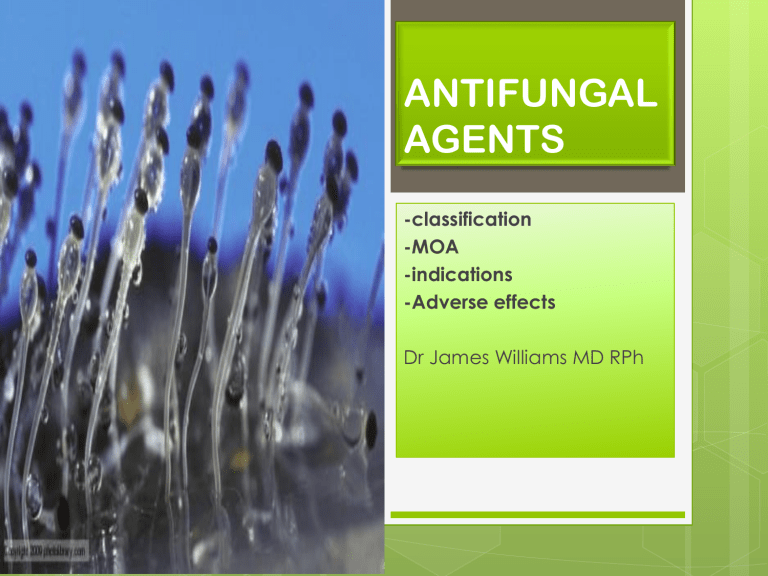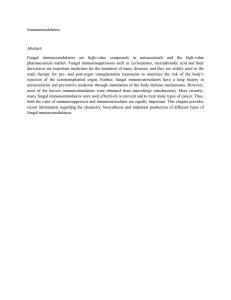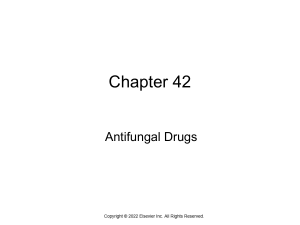Antifungal Agents: Classification, MOA, Indications, & Effects
advertisement

ANTIFUNGAL AGENTS -classification -MOA -indications -Adverse effects Dr James Williams MD RPh Fungi are eukaryotic, heterotrophic (not self sustaining) organisms that live as saprobes or parasites. They are complex organisms in comparison to bacteria. Fungal infections are also called as mycoses. They have nucleus and well defined nuclear membrane, and chromosomes. they have rigid cell wall composed of chitin ( N – acetylglucosamine ) where as bacterial cell wall is composed of peptidoglycan . fungal cell membrane contains ergosterol. Fungal infection SUPERFICIAL Dermatomycoses affecting skin, hair or nails. SYSTEMIC Candidiasis cryptococosis, Aspergillosis, Candidiasis Blastomycosis, Histoplasmosis, Coccidioidomycosi s, Paracoccidioidomy cosis Drug Classification A) Drugs that disrupt fungal cell membrane i) Polyenes Amphotericin Nystatin Natamycin ii) Azoles A) Imidazole Ketoconazole Butaxonazole Clotrimazole Econazole Miconazole Oxiconazole Sulconazole B) Triazole Fluconazole Itraconazole Tioconazole iii) Allylamines Terbinafine Naftifine Butenafine vi) Echinocandins caspofungin B)Drugs that inhibits mitosis Griseofulvin C)Drugs that inhibits DNA synthesis flucytosine Miscellaneous Haloprogi Tolnaftate Whitefield's ointment Ciclopirox olamine Diagram showing mechanism of action of different anti fungal durgs POLYENE ANTIBIOTICS They act by: Binding to sterol in cell membrane. Deformity in plasma membrane occurs Interferes with permeability and with transport functions This allows leakage of intracellular ions and enzymes especially loss of intracellular k+ cell death. They bind selectively to ergosterol in fungus but not in mammalian cell wall. AMPHOTERICIN B It is macrolide antibiotic large lactone ring. Poorly absorbed orally, useful for fungal infection of gastrointestinal tract. Locally used in corneal ulcers, arthritis and candidial bladder irrigation For systemic infections given as slow I/V infusion. Highly protein bound. Penetration through BBB is poor but increases in inflamed meninges. Excreted slowly via kidneys, traces found in urine for months after cessation of drugs. Half life 15 days Drug of choice for most systemic infections. Course of treatment lasts 6-12 weeks. Dose 0.5-1 mg\kg\day. ADVERSE EFFECTS: Most serious is renal toxicity, which occurs in 80% of patients. Hypokalaemia in 25% of patients, requiring potassium supplementation. Hypomagnesaemia Anemia Impaired hepatic function Thrombocytopenia Liposomal preparations of amphotericin B(newer preparations) To reduce the toxicity of amphotericin B ,several new formulations have been developed in which amphotericin B is packaged in a lipid-associated delivery system, to assume that they will bind less to mammalian cell. Lipid vehicle act as a reservoir, reducing binding to human cell. In this way it permits a larger doses, even five times more than colloidal preparation, they have better clearance . Clinically they have more efficacy , less nephrotoxicity. But these are very expensive. Nystatin It is polyene macrolide,similar in structure to amphotericin and with same mechanism of action. Too Not toxic for systemic use absorbed from GIT /skin therefore administered orally. Prevent or treat superficial candidiasis of mouth, esophagus or intestinal tract, oral suspension of 100,000 U/ml 4 times a day and tablets 500,000 U are used to decrease GIT colonization with Candida. Can be used in combination with antibacterial agents and corticosteroids. AZOLES: a bivalent chemical group composed of two nitrogen atoms. They are antibacterial, antiprotozoal, anthelminthic and antifungal. These are group of synthetic fungistatic agents. They have broad spectrum of activity. Inhibit the fungal cytochrome P450 3A enzyme , (lanosine 14-desmethylase ),which is responsible for converting lanosterol to ergosterol, the main sterol in the fungal cell membrane, this alters fluidity of the membrane, thus inhibiting the growth of fungi. IMIDAZOLES Ketoconazole, miconazole, clotrimazole, isoconazole , Tioconazole They interfere with fungal oxidative enzymes to cause lethal accumulation of hydrogen peroxide. they reduce the formation of ergosterol by inhibition of fungal cytochrome P450 enzyme, which become permeable to cellular constituent TRIAZOLES: Fluconazole, itraconazole, voriconazole They damage the fungal cell membrane by inhibiting enzyme desmethylase . They are selective Penetrate to CNS Resistant to degradation Cause less endocrine disturbance. KETACONAZOLE: First azole that could be given orally to treat systemic fungal infections. Well absorbed orally as acidic environment favours its dissolution. Only administered orally. After oral administration of 200,400 and 800 mg, plasma conc. reaches to 4.8 and 20 ug/ml. Half mg life increases with dose and it is 7-8 hrs with 800 Decrease in the ergosterol in the fungal membrane by ketoconazle reduces the fungicidal action of amphotericin. Oral dose 400 mg daily. As it inhibits steroid biosynthesis, several endocrinological abnormalities may be evident as menstrual abnormalities, gynecomastia, decreased libido and impotency. Contraindicated in pregnancy. ITRACONAZOLE It is a synthetic triazole it is new drug It lacks endocrine side effects of ketoconazole. It has broad spectrum activirty Administered orally as well as I/V. Do not penetrate CSF adequately. Dose 100 mg twice daily with food, initially 300 mg thrice daily as a loading dose hypertriglyceridemia, Hypokalaemia, hepatotoxicty FLUCONAZOLE It is fluorinated bistriazole. Completely absorbed from GIT Excellent bioavailability by oral route. Concentration in plasma is same by oral or I/v route Drug interactions are less common. It easily penetrate CSF and is a drug of choice in cryptococcal meningitis and coccido mycosis Candidiasis: 200 mg on 1st day then 100 mg daily for 2 weeks. Cryptococcosis: 400 mg daily for 8 weeks in meningitis. Hepatic failure may lead to death It is highly teratogenic. Voriconazole A new drug available in i.v and oral fromulations. recommended dosage is 400 mg/ day high biological availability when given orally hepatic metabolism predominant. it is similar to itraconazole but more potent. FLUCYTOSINE Has useful activity against Candida and Cryptococcus. it is synthetic pyrimidine antimetabolite that is often used in combination with amphotericin B. Mechanism of action It is converted to antimetabolite 5-florouracil in a fungal cell. This 5-FU inhibits thymidylate synthetase enzyme and thus DNA synthesis. dose 100-150 mg /kg per day divided into 4 doses. Generally use in combination with amphotericin For cryptococcal meningitis in AIDS patients Side effects: reversible neutropenia, thrombocytopenia and occasional bone marrow depression. Caspofungin It is echinocandin class of antifungal drugs it interferes with the synthesis of fungal cell wall by inhibiting synthesis of D-glucan. especially useful for aspergillus and candida. not active orally. Has half life of 9-11 hours Adverse effects include nausea ,vomiting, flushing very expensive GRISEOFULVIN Isolated from Pencillium griseofulvum It interacts with microtubules and interferes with mitosis. Uses Mycotic diseases of skin, hair (particularly for scalp) , nail. It is also highly effective in athlete's foot Peripheral neuritis Lethargy mental confusion impairment in performance of routine task fatigue, vertigo ,syncope, blurred vision. Comparison of Azoles fungistatic drugs Topical anti fungal preparations Topical azole derivatives Ciclopirox olamine Naftifine Terbinafine Butenafine tolnaftate Nystatin and Amphotericin Future prospects Posaconazole azoles. & rabuconazole newer Very effective in treatment of zygomycosis in immunocompromised Nikkomycins newer antifungals act by inhibiting chitin synthesis. Sordarinsupcoming Inhibits fungal growth by blocking elongation factor2. Two class of antifungals new echinocandins Micafungin Anidulafungin Effective in immunocomprimised pts against aspergillus & candida infections.





